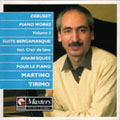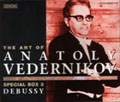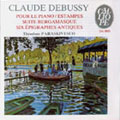Recomenndable
Discs |

     |
"Études / Berceuse Héroïque / Morceau de Concours / Suite Bergamasque" (Saga : EC 3383-2)
Livía Rév
(piano)
A Hungary-born lady with incredible technic - Livía Rév -
has recorded Debussy's works for two times. This is from the her first
Debussy cycle in around 1980. Because her playing style can be described
as keen and massive and the performance sometimes sounds stronger than
mens' do, it is hard to imagine her pianism fits this modest suite. However,
the performance is very much delicate and modest. She clarified the structure
of each composition lyrically by refrained from depending on many pedals,
which let each tone in vertical spectrum, and made the sound three-dimensional.
Even though her performance does not contain any best performance for each
movement, this should be considered the best performance of the suite in
a total average. The current situation, that her recordings for Saga is
totally ignored (because she is not French?) by the critics throughout
the world, is clearly unreasonable. Any publisher who considers themselves
as they posess the real love and understanding of modernist classical music
should let the discs to come into the acclaim again. |

     |
"Piano Works Vol. 3 :
Suite Bergamasque / Images Oubliées, lent : vif / Rêverie / Deux Arabesques / Danse / Pour le Piano / Ballade / Nocturne / Danse Bohémienne / Valse Romantique" (IMP: MCD 24)
Martino Tirimo (p)
A Greek pianist, Martino Tirimo is still remained relatively unknown. His
performance style is totally different from Livía Rév, characterized
by his modest, gentle, decent and sober expression. Because of such pianism,
we can not help wondering whether his style won't fit the witticism in
Debussy's works. But this volume 3 of his Debussy recordings is a real
masterpiece. The best feature of his recording of Bergamasque is, it has
the BEST performance of 'Clair de Lune'. I can not recall any recordings
ever made with such sincerity and delicacy, sounds like a elaborate glasswork.
Although of its quality of performance, this recording is also significantly
underrated by almost of all critics in the world, this situation makes
really no sense. |

    |
"Préludes / Suite Bergamasque / Images 1, 2 / Jardins sous
la Pluie / 12 Études / Pour le Piano (Denon : COCQ-83040-42)
Anatoly Vedernikov
(piano)
This virtuoso recording from Russia (previously Soviet Union) is clearly
one of the most fruitful gift of the end of the cold war. Although the
existence of this recording was known in some keenest listeners because
of its virtuosity, he had restricted to tour abroad and his recordings
had been in veil for many years. But fortunately, he had recorded Debussy
little by little at that time. We can easily imagine how much the recording
gave a shock to the western critics and listeners when it came to be published
for the first time in 1995, by knowing the fact that the recording was
immediately selected the grand prix disc of the Record Academy Award in
the year. Apparently his first repertoire, which was Bach, destinguished
his style of interpretation and performance of Debussy also. In other words,
his Debussy was very much structured and so muscular as Paraskivesco did.
Although the duration of Clair de Lune was too long (6:57 ; the longest
duration as far as I know), the performance of others are so textural with
his extraordinary arpeggio. |

   
|
"Pour le Piano / Estampes / Suite Bergamasque / Nocturne / Six Epigraphes
Antiques" (Calliope : CAL 9833)
Théodore Paraskivesco
(piano) Jacques Rouvier (piano)*
Since its emergence in the latter half of 1970s with this recording, this
pianist - Théodore Paraskivesco, has been seen as one of the most
cherished performers of Debussy, although the fact has been restrictedly
known by the most enthusiastic listeners. Actually, his Debussy is less
sophisticated in witticism, but has much more of contextual staccato and
more of sincerity to original score in his interpretation and playing which
sounds like a ware made by hands of a traditional craftman. His interpretation
of works such as 'Estampes' or 'Suite Bergamasque' definitely makes the
highlight of this recording, resembles Vedernikov in many aspects which
can be characterized as the their Slavic inheritance in interpretation
- more structural, more contextural, more unrefined in witticism. Also
his interpretation is shorter than Vedernikov did (5:38). |

    |
"Children's
Corner / Suite Bergamasque / Six Épigraphes Antiques / Pour le Piano" (Harmonia Mundi : HMC 901504)
Georges Pludermacher
(piano)
Since I unexpectedly selected two recordings in the same manner of textural
performance as above, here I would like to introduce one more recordings
played in a French manner. This recording was performed by a French pianist
George Pludermacher. He is a professor of National Conservatory of Music
in France. He was born in 1944 and has won several international piano
conpetitions such as Liese or Geza Anda. He is not a kind of pianist of
virtuosity but of sensitiveness in piano touch and the refined way of interpretation.
This Debussy was recorded when he was 50 years' old in the middle of 1990
and those are printed in two compact discs. Although the other one was
played a bit dimly, this volume is a masterpiece. Even though he could
not play the best in 'Clair de Lune', this Bergamasque can be recommended
because of its modest and sophisticatedly warm interpretation which can
be seen as a typical French-rooted style of performance. |
The rate is just for the performance of 'Bergamasque Suite' only. |
